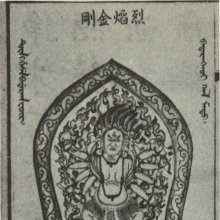Vajrajvalanalarka, Vajrajvālānalārka, Vajra-jvalanalarka, Vajrajvala-analarka: 3 definitions
Introduction:
Vajrajvalanalarka means something in Buddhism, Pali, Hinduism, Sanskrit. If you want to know the exact meaning, history, etymology or English translation of this term then check out the descriptions on this page. Add your comment or reference to a book if you want to contribute to this summary article.
Images (photo gallery)
In Buddhism
Tibetan Buddhism (Vajrayana or tantric Buddhism)
Source: archive.org: The Indian Buddhist Iconography1) Vajrajvālānalārka (वज्रज्वालानलार्क) refers to one of the various emanations of Akṣobhya having their Sādhana described in the 5th-century Sādhanamālā (a collection of sādhana texts that contain detailed instructions for rituals).—His Colour is blue; his Āsana is the ālīḍha; his Vāhana is Viṣṇu and his wife he has four faces and eight arms.—Only one sādhana in the Sādhanamālā describes his [Vajrajvālānalārka] form.
The Dhyāna (meditation instructions) of Vajrajvālānalārka described in the Sādhanamālā as follows:—
“The worshipper should conceive himself as Vajrajvalanalarka of blue colour, whose person radiates fiery flames. He is four-faced and eight-armed, and his four-faces display the sentiments of love, heroism, disgust and compassion. He carries in his four right hands the vajra, the sword, the cakra and the arrow, and in the four left the ghaṇṭā, the bow, the noose and the khaṭvāṅga surmounted by a banner of variegated colour. His brown hair resembles a burning flame and he is decked in ornaments of bracelet, armlet, girdle, nūpura, torque, ear-ring and crown consisting of the (eight) great lords of the frightful serpents. He stands in the ālīḍha attitude and tramples upon Viṣṇu with his consort who are clever in enveloping everything with their great Māyā (deception)”.
2) Vajrajvālānalārka (वज्रज्वालानलार्क) is another name for Ṭikkarāja: one of the ten deities of the quarters (Dikpāla) presiding over the Agni corner, commonly depicted in Buddhist Iconography, and mentioned in the 11th-century Niṣpannayogāvalī of Mahāpaṇḍita Abhayākara.—His Colour is blue; he has three faces and six arms.—Ṭakkirāja as the guardian of the Agni corner is very frequently referred to in the Niṣpannayogāvalī.—In the vajrahūṃkāra-maṇḍala his name is Vajrayakṣa. In the dharmadhātuvagīśvara-maṇḍala he is Vajrajvālānalārka.
Source: OSU Press: Cakrasamvara SamadhiVajrajvālānalārka (वज्रज्वालानलार्क) refers to the “vajra-radiently-blazing-fire” [i.e., oṃ vajrajvālānalārka hūṃ phaṭ], according to the Cakrasaṃvara Samādhi [i.e., Cakrasamvara Meditation] ritual often performed in combination with the Cakrasaṃvara Samādhi, which refers to the primary pūjā and sādhanā practice of Newah Mahāyāna-Vajrayāna Buddhists in Nepal.

Tibetan Buddhism includes schools such as Nyingma, Kadampa, Kagyu and Gelug. Their primary canon of literature is divided in two broad categories: The Kangyur, which consists of Buddha’s words, and the Tengyur, which includes commentaries from various sources. Esotericism and tantra techniques (vajrayāna) are collected indepently.
Languages of India and abroad
Sanskrit dictionary
Source: Cologne Digital Sanskrit Dictionaries: Edgerton Buddhist Hybrid Sanskrit DictionaryVajrajvālānalārka (वज्रज्वालानलार्क).—name of a deity: Sādhanamālā 512.1.
Sanskrit, also spelled संस्कृतम् (saṃskṛtam), is an ancient language of India commonly seen as the grandmother of the Indo-European language family (even English!). Closely allied with Prakrit and Pali, Sanskrit is more exhaustive in both grammar and terms and has the most extensive collection of literature in the world, greatly surpassing its sister-languages Greek and Latin.
See also (Relevant definitions)
Partial matches: Analarka, Vajra, Jvalanalarka, Vajrajvala.
Full-text: Jvalanalarka, Vajrayaksha, Takkiraja.
Relevant text
No search results for Vajrajvalanalarka, Vajrajvālānalārka, Vajra-jvalanalarka, Vajrajvala-analarka, Vajrajvāla-analārka, Vajra-jvālānalārka; (plurals include: Vajrajvalanalarkas, Vajrajvālānalārkas, jvalanalarkas, analarkas, analārkas, jvālānalārkas) in any book or story.

